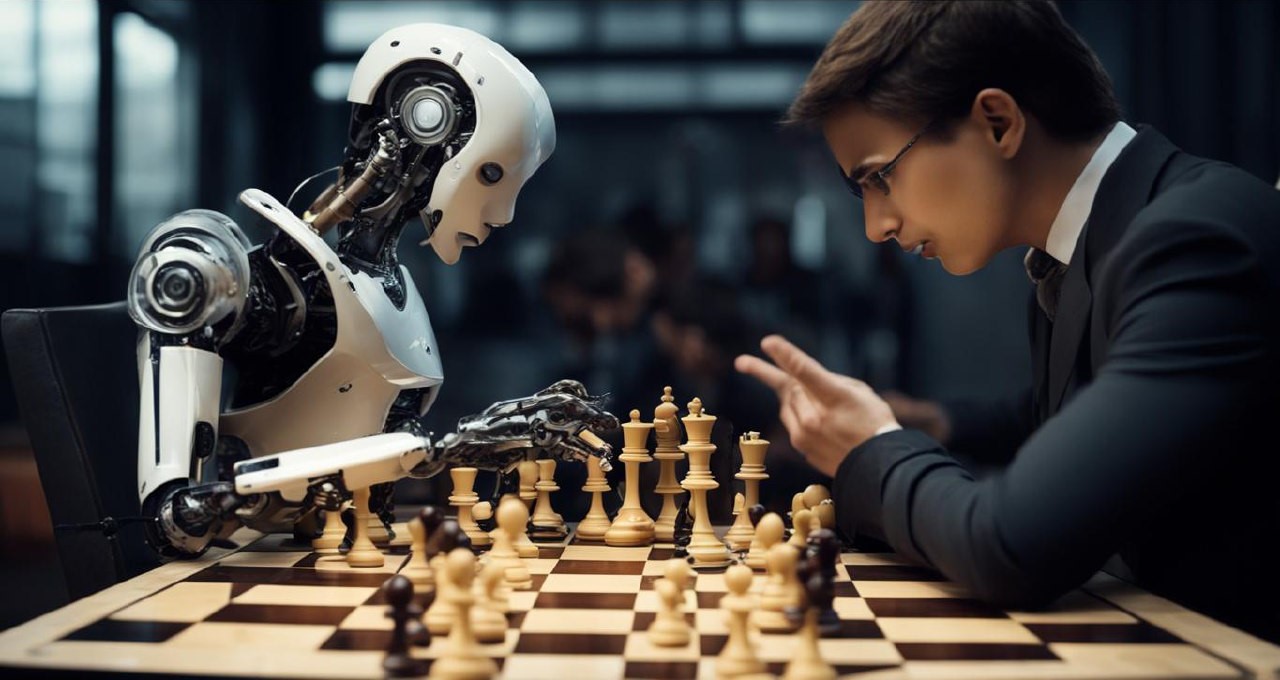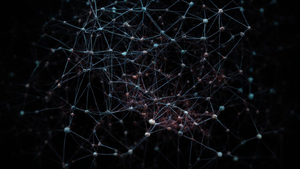Reinforcement Learning

Reinforcement learning is a branch of machine learning concerned with how intelligent agents ought to take actions in an environment in order to maximize some notion of cumulative reward. The agent learns to achieve a goal in an uncertain, potentially complex environment through trial and error interactions without any supervisor. In reinforcement learning, the learning algorithm receives feedback in the form of rewards or penalties as it navigates its problem space. The goal is for the agent to learn the optimal strategy, called a policy, that will help it make decisions under various circumstances.
Key Components:
Agent: This is the entity that perceives its environment, selects and performs actions.
Environment: It includes everything outside the agent which interacts with it.
State (s): Represents the current situation/output at each time step.
Action (a): Choice made by the agent affecting its state.
Reward (r): Indicates how good or bad an action was, given a state.
Policy: Strategy or rule used by an agent to decide on an action based on different states.
Value Function: Measures how good certain states are for making decisions with respect to future rewards.
Q-Learning Algorithm: A model-free technique for estimating optimal Q-values using Temporal Difference methods which can be used to find an optimal action-selection policy for any given Markov decision process.
Types of Reinforcement Learning:
- Value-Based RL:
- Utilizes value functions to estimate how good certain states/actions are.
- Common algorithms include Q-learning and Deep Q-Networks (DQN).
Policy-Based RL: Directly learns policies aiming at finding better policies rather than approximating value functions. - Algorithms like REINFORCE and Proximal Policy Optimization belong here.
Model-Based RL: Learns a model of the environment from observed data before planning over it.
Applications:
- Robotics
- Game playing
- Finance
- Recommendation systems
- Healthcare
In summary, reinforcement learning tackles problems where understanding sequential decision-making processes is crucial such as real-time strategy games or robotics control tasks by enabling machines/agents to learn from experience and interact with environments autonomously based on rewards received due to their behavior.
Training Robots to Make Decisions for Maximum Rewards

Let's imagine you want to train a robot to play a game, like chess. Reinforcement learning is a type of machine learning that focuses on training an agent (in this case, the robot) to make decisions in an environment (the chessboard) in order to maximize its rewards.
In reinforcement learning, the agent takes actions based on its current state in the environment. The actions can be moving a piece on the chessboard, for instance. After taking an action, the agent receives feedback or observations from the environment. This feedback comes in the form of rewards or penalties depending on how well it performs during gameplay.
For example, if the agent wins a game of chess, it would receive a positive reward; if it loses or makes a bad move, it would receive a negative reward or penalty. The goal of reinforcement learning is for the agent to learn which actions result in higher rewards and avoid actions that give lower rewards.
To achieve this, reinforcement learning algorithms use different strategies called policies. Policies are rules or decision-making processes that guide agents towards good actions by maximizing their expected long-term benefits or cumulative rewards.
Over time, through trial and error and continuous interaction with the environment, reinforced by receiving feedback about its performance (rewards/penalties), the agent learns which actions lead to desirable outcomes and adjusts its policies accordingly.
By repeating this process many times, using techniques such as Q-learning or policy gradients, reinforcement learning algorithms can enable machines like robots to autonomously improve their decision-making abilities in complex environments like playing chess or controlling self-driving cars.
Does that help clarify how reinforcement learning works?
Reinforcement Learning: Q-Learning
Reinforcement learning is a type of machine learning wherein an agent learns to make decisions by taking actions in an environment to maximize some notion of cumulative reward. Q-learning is a popular model-free reinforcement learning algorithm that aims to learn the optimal action-selection policy for any given Markov decision process (MDP).
Key Concepts:
Q-Values: In Q-learning, the agent maintains a table of Q-values, which represent the expected cumulative rewards for taking a particular action in a specific state. The goal is to learn these values such that the agent can make decisions that maximize long-term rewards.
Exploration vs Exploitation: A key challenge in reinforcement learning is balancing exploration (trying out different actions to discover their rewards) and exploitation (choosing actions based on current knowledge). Q-learning uses an epsilon-greedy strategy to balance exploration and exploitation.
Bellman Equation: At the core of Q-learning is the Bellman equation, which relates the value of a state-action pair to the value of its neighboring states. By iteratively updating Q-values based on this equation, the agent moves towards learning an optimal policy.
Updating Q-Values: The update rule in Q-learning involves adjusting the current estimate of a state-action pair's value towards a new target value, computed using immediate rewards and estimated future rewards through subsequent actions.
Convergence and Robustness: With sufficient exploration and appropriate hyperparameters, Q-learning has been shown to converge to optimal policies under certain conditions, making it robust across various environments.
Applications:
Game Playing: One classic application of Q-learning is developing AI agents capable of playing games like Tic-Tac-Toe or Atari games by learning optimal strategies through trial-and-error interactions with game environments.
Robotics Control: In robotics, Q-learning can be used for tasks like navigating through dynamic environments or optimizing trajectories by rewarding efficient motion planning.
Recommendation Systems: Utilizing reinforcement learning techniques like Q-learning can improve recommendation systems by dynamically adapting suggestions based on user preferences and feedback loops.
Challenges:
Curse of Dimensionality: Scaling up traditional tabular implementations of Q-learning becomes challenging as state spaces grow larger due to exponential memory requirements.
Exploration Strategies: Designing effective exploration policies while ensuring convergence poses challenges as agents may get stuck in sub-optimal solutions due to insufficiently exploring all possible states and actions.
Stability and Convergence: Tuning hyperparameters such as learning rates and discount factors requires careful consideration as inappropriate settings may lead to slow training or divergence issues.
Q-learning offers an intuitive yet powerful approach for solving reinforcement learning problems by iteratively improving action-selection policies based on learned estimates. While facing computational challenges with scalability and fine-tuning requirements, its versatility makes it widely applicable across domains aiming at automatic decision-making processes under uncertainty.
Understanding Reinforcement Learning and the Q-Learning Algorithm

Imagine you have a pet dog and you want to teach it some tricks. To do this, you reward your dog with treats when it performs the correct behavior. Over time, your dog learns through trial and error which actions lead to rewards.
In reinforcement learning, an agent (like your pet dog) interacts with an environment to learn optimal actions based on rewards. The agent's goal is to maximize its cumulative reward over time.
Q-Learning is one popular algorithm used in reinforcement learning. It works by creating a table called a Q-table that maps states and actions to expected future rewards. Initially, the Q-values (rewards) in the table are random or set at zero.
The agent explores different actions in the environment until it receives feedback in the form of rewards. Based on these rewards, it updates the corresponding Q-values in its Q-table using a formula known as the Bellman equation.
With each interaction, the agent gradually learns which sequence of actions leads to better rewards by updating its Q-table values accordingly. Over time, through repeated trials and exploration, Q-Learning converges towards finding optimal action-value estimates that maximize expected long-term reward.
So basically, just like teaching your pet dog tricks through rewarding good behavior, Reinforcement Learning: Q-Learning algorithm helps an agent learn through trial and error by encouraging favorable actions with reliable positive outcomes while discouraging unfavorable ones.
Deep Q-Networks (DQN)
Reinforcement Learning is a machine learning paradigm where an agent learns to make decisions by taking actions in an environment to maximize a cumulative reward. Deep Q-Networks (DQN) represent a powerful approach within the field of reinforcement learning that combines deep neural networks with the Q-learning algorithm for training agents to perform complex tasks.
Key Components of DQN:
Q-Learning: Q-learning is a model-free reinforcement learning algorithm used to approximate the action-value function, which determines the value of taking a particular action in a given state. The goal is to learn the optimal policy that maximizes long-term rewards.
Deep Neural Networks: In DQN, deep neural networks are utilized as function approximators to estimate the Q-values for different actions in each state. These networks can handle high-dimensional input spaces and are capable of learning complex patterns and representations.
Experience Replay: Experience replay is an important technique used in DQN training, where past experiences (state, action, reward, next state) are stored in a replay memory buffer and sampled randomly during training. This helps stabilize learning by breaking correlations between consecutive samples and improving data efficiency.
Target Networks: To improve stability during training, DQN employs two separate neural network models: one for estimating Q-values (online network) and another for calculating target Q-values (target network). Periodically updating the target network's parameters with those from the online network helps prevent divergence during optimization.
Training Process of DQN:
Initialization: Initialize the online network and target network with random weights.
Exploration vs Exploitation: During training, balance exploration (trying new actions) and exploitation (taking known good actions) using strategies like ε-greedy or softmax exploration policies.
Action Selection & Execution: Select an action based on current policy using either epsilon-greedy strategy or learned behavior through the neural network.
Observation & State Transition: Observe next state and reward after executing selected action in the environment.
Experience Replay & Update Rule:
- Store experience tuple <state, action, reward, next_state> into replay memory buffer.
- Sample mini-batches from replay memory uniformly at random.
- Compute loss between predicted Q-value from online network and target value from target network.
- Backpropagate loss through online network to update weights using gradient descent.
Target Network Update:
- Update target network weights periodically by copying parameters from online/network.
By combining these components effectively, Deep Q-Networks have demonstrated success in various challenging environments such as Atari games or robotic control tasks, showcasing their potential as versatile tools for solving complex decision-making problems through reinforcement learning techniques.
Reinforcement Learning with Deep Q-Networks

To understand DQNs better, let's imagine you have a robot that needs to navigate through a maze. The robot knows its current position and can take actions like moving up, down, left, or right. The goal of the robot is to reach the target location efficiently while avoiding obstacles.
Now, imagine that the robot doesn't know anything about the maze initially. It can only explore and learn from trial and error. This is where reinforcement learning comes in.
The DQN algorithm allows us to teach the robot how to navigate through the maze effectively using a combination of exploration and exploitation. Here's how it works:
Exploration: Initially, the robot takes random actions and explores different paths in the maze. It collects data about its experiences during this phase.
Experience Replay: The collected experiences are stored in memory for later use. This prevents forgetting valuable information as new experiences come along.
Action Selection: As training progresses, instead of taking random actions all the time, the DQN selects actions based on their expected rewards using a neural network called Q-network.
Exploitation: The selected action is executed, and feedback (reward or penalty) is received from reaching certain states or goals in the environment.
Updating Q-values: After receiving feedback, we update our estimations of each action's value (or Q-value). We aim to improve these values over time based on reinforcement signals received from exploring the environment.
By repeating these steps over multiple iterations or episodes of training, the DQN gradually learns which actions maximize rewards in different situations within the maze. Ultimately, it becomes proficient at navigating towards targets while avoiding obstacles efficiently without explicitly needing any prior knowledge about mazes.
This example showcases how Deep Q-Networks can be used in reinforcement learning to train agents, like robots, to autonomously learn and make decisions based on their interaction with the environment.
State-Action-Reward-State-Action (SARSA)

Algorithm in reinforcement learning is the State-Action-Reward-State-Action (SARSA) algorithm, which is used for on-policy learning.
Components of the SARSA Algorithm:
State (s): In SARSA, the agent interacts with the environment by transitioning between different states. A state represents a particular configuration or situation that the agent finds itself in.
Action (a): At each state, the agent takes an action based on its policy. An action represents the decision made by the agent to transition from one state to another.
Reward (r): After taking an action at a specific state, the agent receives a reward from the environment. The goal of the agent is to learn a policy that maximizes cumulative rewards over time.
State-Action Pair (s, a): In SARSA, learning happens based on pairs of states and actions taken by the agent in those states. The update rule incorporates these pairs to adjust policy towards optimal behavior.
Key Concepts of SARSA Algorithm:
On-Policy Learning: This means that SARSA learns and improves policies while following them during exploration.
Temporal Difference Learning: SARSA uses temporal difference methods to estimate value functions and improve policies based on observed outcomes.
Working Principle of SARSA Algorithm:
Initialization: Initialize Q-table with arbitrary values or use function approximators for continuous spaces.
Interaction: Agent selects actions based on its current policy and performs these actions in an environment.
Update Q-values: Update Q-values based on observed rewards and next-state information using temporal difference learning:
$Q(s,a) \leftarrow Q(s,a) + \alpha [r + \gamma Q(s',a') - Q(s,a)]$
where: -$\alpha$: Learning rate -$\gamma$: Discount factor -$(s,a,r,s',a')$: Current state-action pair, reward received, next state, and next action.Policy Improvement: Update policy based on updated Q-values using epsilon-greedy strategy or SoftMax exploration.
Iteration: Repeat steps 2-4 until convergence criteria are met or after a specified number of iterations.
By iteratively updating Q-values based on experienced rewards through interactions with environments while following certain policies, the SARSA algorithm aims to find an optimal policy that results in maximum cumulative rewards over time.
Deep Deterministic Policy Gradients (DDPG)

Popular algorithm within reinforcement learning is Deep Deterministic Policy Gradients (DDPG), which combines deep learning techniques with continuous action spaces.
Key Components of DDPG:
Actor-Critic Architecture:
- DDPG uses an actor-critic architecture consisting of two neural networks:
- Actor: The actor network suggests actions based on the current state.
- Critic: The critic network evaluates the actions recommended by the actor.
- DDPG uses an actor-critic architecture consisting of two neural networks:
Target Networks:
- To stabilize training, DDPG introduces target networks that are used to compute target Q-values for both the actor and critic networks.
Experience Replay:
- Experience replay allows DDPG to store transitions observed during interaction with the environment and randomly sample mini-batches for training, increasing data efficiency.
Soft Updates:
- Instead of updating the target networks directly, soft updates slowly blend parameters from learned networks into target networks, helping in more stable training.
Policy Gradient Method:
- DDPG uses policy gradients to update the actor network's weights based on how good or bad an action was in a particular state-inducing improved strategies over time.
Deterministic Policy:
- Unlike stochastic policies commonly used in reinforcement learning, DDPG learns deterministic policies that output specific continuous actions.
Off-Policy Learning:
- DDPG is an off-policy algorithm as it learns from past experiences stored in the replay buffer rather than just relying on current interactions with the environment.
Advantages of DDPG:
- Well-suited for environments with continuous action spaces.
- Handles high-dimensional inputs effectively using deep neural networks.
- Stable and efficient due to experience replay and soft updates mechanisms.
- Suitable for tasks like robotic control, financial trading, and game playing where precise control is needed.
Deep Deterministic Policy Gradients (DDPG) present a powerful approach towards solving reinforcement learning problems involving continuous action spaces through its unique combination of deep neural networks, policy gradients, and off-policy learning mechanisms.
Proximal Policy Optimization (PPO)

One popular algorithm in this field is Proximal Policy Optimization (PPO).
Key Idea: PPO focuses on updating the policy with each iteration while keeping changes within a certain "trust region" to ensure stable and efficient learning.
Policy: In PPO, the policy defines the behavior of the agent - it maps states to actions based on learned parameters.
Objective Function: The objective in PPO is typically to maximize the expected sum of rewards obtained from interacting with the environment.
Trust Region: PPO introduces a constraint that limits how much the new policy can deviate from the old policy, thereby preventing large policy updates that could be harmful to learning stability.
Clipping Objective: A key component of PPO is clipping the surrogate objective function calculated during training, which further enforces the trust region property.
Advantages:
- Efficient optimization through sampled data
- Stable training due to limited policy update size
- Effective exploration-exploitation balance
Applications:
- Game playing (e.g., AlphaGo)
- Robotics control
- Finance
Extensions: PPO has inspired various extensions and variations such as TRPO (Trust Region Policy Optimization) and ACKTR (Actor Critic using Kronecker-Factored Trust Region).
Challenges: Training stability, hyperparameter tuning sensitivity, sample efficiency, and balancing exploration with exploitation are some common challenges faced when working with RL algorithms like PPO.
Proximal Policy Optimization is a powerful reinforcement learning algorithm known for its simplicity, effectiveness in handling complex environments, and ability to strike a balance between exploration and exploitation.
Monte Carlo Tree Search (MCTS)
Reinforcement Learning Monte Carlo Tree Search (MCTS) is a popular algorithm used in the field of artificial intelligence, particularly in domains where decision-making and planning under uncertainty are required. MCTS is widely applied in games, robotics, and optimization problems.
Key Components of MCTS:
Monte Carlo Simulation:
- MCTS employs a Monte Carlo simulation technique to approximate the value of different states by sampling possible future outcomes through random simulations or rollouts.
Tree Structure:
- The core idea behind MCTS is to build and explore a tree structure representing potential actions and state transitions from the current state.
Selection:
- During each iteration of MCTS, it selects nodes in the tree to expand based on certain criteria such as UCB1 (Upper Confidence Bound 1).
Expansion:
- After selecting a node, MCTS expands the tree by adding child nodes representing possible actions from that state.
Simulation:
- Once a leaf node is reached, MCTS conducts simulations (rollouts) starting from that node until an end state or terminal condition is met.
Backpropagation:
- The final outcome of the simulation is backpropagated up the tree towards the root node, updating statistics like visit counts and cumulative rewards for each action/state.
Advantages of using MCTS:
Robustness:
- It performs well even in scenarios with complex rules or environments where traditional search algorithms may struggle.
Exploration-Exploitation Tradeoff:
- MCTS balances exploration (discovering new possibilities) with exploitation (leveraging known information) efficiently through its probabilistic selection strategy.
Adaptability:
- Due to its ability to adapt during runtime based on limited domain knowledge and sample interactions with an environment or game, it can be applied to diverse problem domains without extensive domain-specific modifications.
High Performance:
- In many cases, especially within game-playing AI systems like AlphaZero developed by DeepMind for games like Chess and Go, MTS has demonstrated superior performance compared to other traditional search techniques.
Overall, Reinforcement Learning Monte Carlo Tree Search offers an elegant solution for sequential decision-making under uncertainty by iteratively improving decision strategies through simulated experience and thoughtful exploration-exploitation balance.
Sponsored
Sponsored
Sponsored
Explore More:

Model Evaluation and Selection
Topic model evaluation and selection are crucial steps in the process of building...

Feature Engineering
Feature engineering is the process of selecting, creating, and transforming features (inputs) in...

Natural Language Processing (NLP)
Natural Language Processing (NLP) is a subfield of artificial intelligence that focuses on...

Neural Networks and Deep Learning
Neural networks are a class of algorithms modeled after the human brain's neural...

Dimensionality Reduction: Autoencoders
Autoencoders are a type of artificial neural network used for learning efficient representations...

Dimensionality Reduction: Factor Analysis
Factor analysis is a powerful technique used in the field of machine learning...

Dimensionality Reduction: Independent Component Analysis (ICA)
Independent Component Analysis (ICA) is a dimensionality reduction technique commonly used in machine...

Dimensionality Reduction: t-Distributed Stochastic Neighbor Embedding (t-SNE)
Dimensionality reduction is a fundamental technique in machine learning and data visualization that...

Dimensionality Reduction: Principal Component Analysis (PCA)
Principal Component Analysis (PCA) is a popular dimensionality reduction technique used in machine...

Unsupervised Learning: Dimensionality Reduction
Unsupervised learning dimensionality reduction is a crucial concept in machine learning that deals...

Clustering: Gaussian Mixture Models
Clustering is a fundamental unsupervised learning technique used to identify inherent structures in...

Clustering: DBSCAN
DBSCAN (Density-Based Spatial Clustering of Applications with Noise) is a popular clustering algorithm...

Clustering: Hierarchical Clustering
Hierarchical clustering is a popular unsupervised machine learning technique used to group similar...

Clustering: K-Means
Clustering is an unsupervised machine learning technique that aims to partition a set...

Unsupervised Learning: Clustering
Unsupervised learning clustering is a fundamental concept in machine learning that involves identifying...

Unsupervised Learning
Unsupervised learning is a type of machine learning where the model is trained...